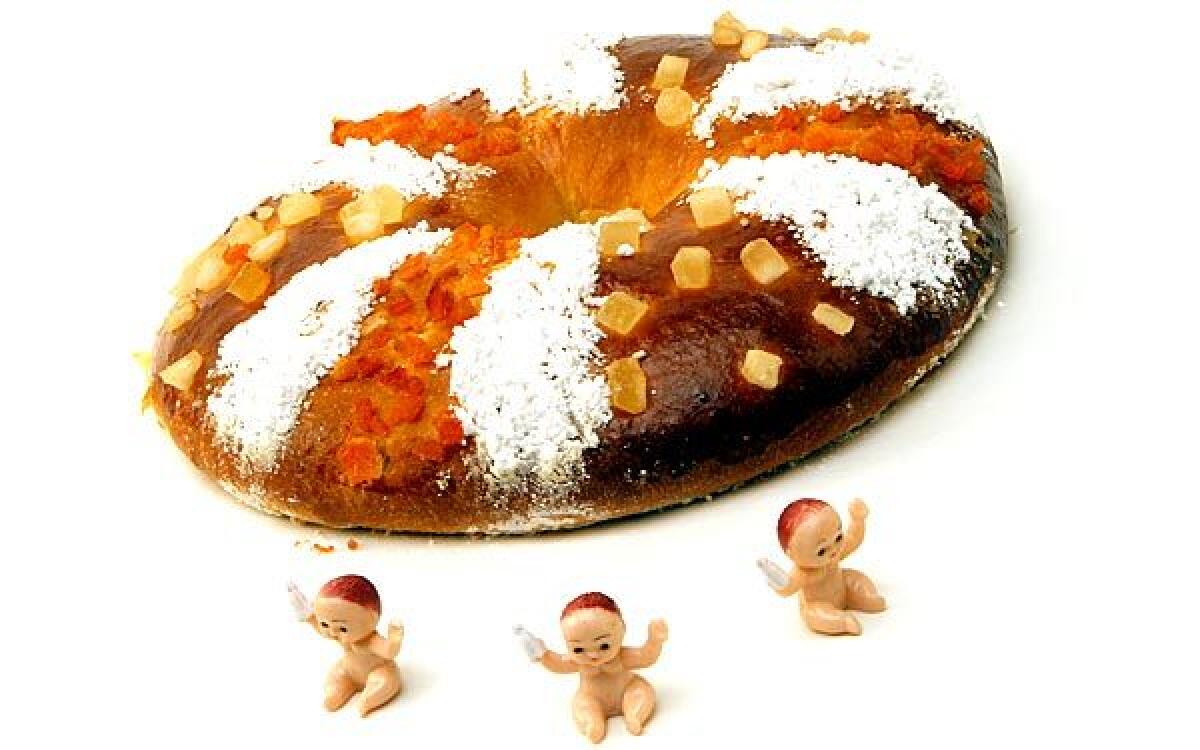Mexican feast fit for a king

- Share via
Because I left Mexico when I was 6, my recollections of our holiday traditions are often dreamlike and vague.
But my memory of Three Kings Day, or el Día de los Reyes Magos, remains vivid because it came right after Christmas, in the first week of January, and it meant there was still one more day of presents left.
In Mexico, there is no busier time on the social calendar than the end of the year, beginning Dec. 12, the feast day of Our Lady of Guadalupe. Then, there are nine days of parties starting Dec. 16 to celebrate Las Posadas, leading up to a big family dinner on Christmas Eve, followed by New Year’s and finally, Epiphany on Jan. 6, when the three wise men were said to have offered their gifts to the baby Jesus.
On Three Kings Day, we would stuff ourselves with enchiladas verdes, tamales, rosca de reyes, or kings cake, and a frothy cup of Mexican hot chocolate at the famous Café de Tacuba in downtown Mexico City. The café was founded in 1912, in a magnificent 17th century home probably once owned by a viceroy, and was where artists, politicians and movie stars would gather.
Today’s scene is less glamorous, given that downtown Mexico City’s historic core has seen better days. However, Café de Tacuba is still a national landmark. It is a prerequisite for visitors to the capital and a place where the food is traditional and quintessentially Mexican. In fact, the menu proudly states that the tamales are made with manteca (lard), “as the tradition requires,” and they are accompanied by atole, a heavy, hot drink made from corn flour, water, unrefined cane sugar, cinnamon, vanilla and chocolate.
As a child, I remember that on the night of Jan. 5, my brother and I were told to each leave a shoe under the Christmas tree. This was a strange tradition that to this day doesn’t make much sense. But I was not about to complain because in the morning we would wake to find small presents in our shoes, apparently delivered by Melchior, Gaspar and Balthazar themselves. My great-aunt reminded me that in our family, the tradition of Santa Claus did not start until the 1940s, when another great-aunt married a Brit who introduced the tradition.
On the evening of Jan. 6, our entire extended family met at Café de Tacuba, where we gorged ourselves, as my relatives had since my great-grandparents’ day.
As a child, I was oblivious to the beauty and history of Café de Tacuba. But now I realize how fortunate we were to have sat in those magnificent handmade wicker chairs where Diego Rivera or Dolores del Rio might have been years earlier, below the restaurant’s vaulted ceilings with walls decorated with Talavera tile from Puebla.
At Café de Tacuba, the food took time. They did not use electronic appliances to make any of the meals; instead, they used stone molcajetes and metates and wooden molinillos to grind and mix and blend the food.
The adults chatted happily for hours after ordering while we children went from table to table playing games. If we did not behave, we were warned that a nun haunted the place and that she would come around and pinch us. Customers swore they saw the tablecloths being straightened by an unseen hand.
Ordering was an ordeal because of the choices. Easy enough were the enchiladas verdes, made with a homemade green salsa, stuffed with chicken and topped with queso Chihuahua and crema. But the tamales were another matter. There were so many varieties! Chicken and green salsa, beef and red salsa, chicken and mole negro, red sauce and chile poblano strips (known as rajas). And then there were the sweet tamales, of strawberry, pineapple or guava. They were fluffy and light as air, leaving us wanting more even when our bellies were absolutely ready to burst.
But then came the clincher — the rosca de reyes and the hot chocolate (known in my family as la bomba). We would dip the piece of cake (really more like a sweet bread than a cake) into the thick hot chocolate and savor the simplicity of the rosca with the richness of the chocolate.
The rosca is a ring of sweet pastry. Its circular shape symbolizes the sky in its perfection and eternity. The size of the rosca depends on the size of your party. Its crust is adorned with colorful crystalline sugars and candied fruit chunks of fig, orange or lemon that are meant to resemble jewels.
The tradition calls for a tiny plastic (or porcelain in those days) baby to be placed inside the rosca. Whoever bites into that part of the rosca and finds a baby doll must throw another party on Feb. 2, Día de la Candelaria, or Candelmas. Most Mexican families buy rosca de reyes at bakeries, but they can be made at home.
Sadly, once my family moved to this country, the tradition of going to the Café de Tacuba ended. But those memories will accompany me forever. And now that I have a family of my own, I like to celebrate the holiday at home with a dinner party and some friends.
As much as I would like to make everything by hand, as is done at the Café de Tacuba, I confess that I sometimes take shortcuts. Many Mexican bakeries in Los Angeles County sell very good rosca de reyes. And I occasionally make the enchiladas with a canned salsa augmented with plenty of chile verde, cilantro and onion.
It is not the Café de Tacuba, but at least the tradition lives on.
More to Read
Eat your way across L.A.
Get our weekly Tasting Notes newsletter for reviews, news and more.
You may occasionally receive promotional content from the Los Angeles Times.










